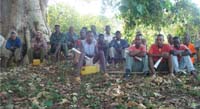20.2 Organising community conversations
In this section, we are going to look at the steps which you should follow when organising a community conversation.
Step 1
Good relationships with senior members of your community will help you to conduct effective community conversations. This will also help the facilitator and the community members to get to know each other and strengthen their relationship. This leads them to feel at ease and able to set out their views and opinions, and will help them to trust and understand each other.
Step 2
Identify the main health problems in the community. At this stage the role of the health worker is to ask strategic questions to help community members identify the main health problems or issues. Remember that as a facilitator of the conversation you should not impose your views or tell them that, ‘your problem is ……’, as this will prevent the community being able to identify their health issues for themselves.
Step 3
During this step, the community will assess and discuss the root causes of the identified health issues (Figure 20.3).

Step 4
Identify and collect together any available resources. This step helps the community to identify resources which will be necessary to help solve the identified health problems.
Step 5
This is decision making. During this step the community prioritises the identified issues and health problems, and starts to plan activities that should be carried out.
Step 6
This is the implementation stage. During this step the community implements what has been planned. Remember that you should include as many members of the community as possible in your health activities, even those who did not attend the community conversation. Doing this will help the community take ownership of the implementation process.
Step 7
This is the stage where you monitor the implementation of any chosen health activities, and make an effort to understand the changes that have taken place in the community. This step helps the community to monitor and evaluate the behavioural changes and the challenges faced at each step.
Now read again the steps outlined above. Clearly, there is a lot to think about. Consider a situation in your community (for example, about the high incidence of malaria) and try finding a way of asking some questions of the community that might raise the issue of malaria.
Of course there are all sorts of ways of developing this. You could begin with a very open-ended question: ‘What do people think are the big health problems in the community?’ or ‘What sorts of illnesses do people notice time and again in their community?’ There may already be a recognition and understanding of the health problem, in which case you could ask how they think the problem might be resolved.
20.1 Community conversation
